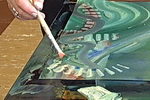




 |
 |
 |
 |
 |
DEVELOPMENT |
ONLINE
PROJECTS |
|||||
 |
Approaches
for Working with Encaustic Medium & Paint Encaustic paint needs to contain wax & colour. The quality of these components & the way in which ingredients interact defines the final character & behavior the paint. Heat is the solvent for the encaustic medium, so no evaporating solvents are needed. |
There are many techniques relating to the
encaustic art wax blocks on the links at the top of
this page. The section
below will be looked at as time unfolds! |
|||
| hotplate palette tins' brushes,rollers |
japanese knives & hot air | hot air & sponges | layering |
| pouring | carving through | crayoning on | embedding collage |
| brushing | iron for close-up palette | dripping | splattering |
| impasto | overlay | dribbling | blowing |
| hotplate | big hotplate ! | iron direct | stylus & tips |
An Apology This is such a huge topic, such a big page, that some time iwas needed to face the work involved in making a worthy reference here. Some topics are sketched in and some have links to other parts of this site that deal primarily with the Encaustic Art range of products. .. unfortunately, this area of the site is now archived and I never did find the time to do all that could be here. |
|
Up to Index - below is some old information on supports... |
|
Card White card gives a good reflectivity for the light that penetrates the
translucent wax colours. Coloured card can also provide an interesting
and effective support for encaustic work. A gloss surface is ideal for
artwork where the process of working colours with heated tools offers a
constantly present opportunity to change the forms of the colour and re-work
the waxes into new patterns, images, etc. Most coloured card is single
faced and so after being work it is best to fix it with a suitable glue
to a more rigid under-board (display board or masonite / MDF are all good. MDF & Plywood You can paint the wax straight onto the MDF surface if you wish, but the wax is easily absorbed and saturating the surface can consume a lot of wax and time. Better perhaps to seal the surface of the MDF with a solution of white wood glue and water. The glue is available in most DIY store and can also be used as an additive for strengthening and water-proofing cement. Mix about 30% glue with 70% water and give one coat of this to the MDF (or plywood). In fact this sealer will work on almost any absorbent surface. Allow it to dry then work with your waxes. Alternatively you could apply an acrylic - clear, white or coloured - or perhaps a gesso. There are numerous working methods for applying the wax, ranging
from the use of molten wax and cold natural hair brushes through
to the use of electric paint stripper hot air guns, heat lamps
and hand held heating wands. We'll add more when time allows and
someone nudges us for more information on this! Line Board This material is rigid but lighter than MDF or plywood. Wax colour
can be applied directly to the line board surface in numerous working
manners and will perform very well for the majority of uses. Fabrics There are many ways to work waxes on fabric. In the 1800's a man named Count
Caylus experimented with comparisons of oil and encaustic artworks. He
placed similar paintings done in each medium in a number of
situations; in an attic (dry), in the cellar (damp), outside
in the open air (weather, sun, rain & frost). According to
his reports the encaustic pieces outlasted the oils in quality
in every situation. Canvas
Up to Index More... |
|